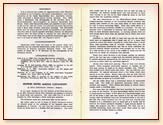|
RESEARCH
AND FIRST PUBLICATIONS
 By
the late 1940s Rica's work was being published in journals
including The Western Australian Naturalist, The
EMU (the journal of the Royal Australasian Ornithologists'
Union), Wildlife, and in the life and letters pages
of the West Australian newspaper. However, it was for
her work on native flora that she was to become best known: By
the late 1940s Rica's work was being published in journals
including The Western Australian Naturalist, The
EMU (the journal of the Royal Australasian Ornithologists'
Union), Wildlife, and in the life and letters pages
of the West Australian newspaper. However, it was for
her work on native flora that she was to become best known:
Anything
that moved in plants I found fascinating, because you realise
that plants are moving things all the time. I mean they're
growing and that's a movement. It's so slow you don't notice
it, but when you get a swift movement, like a trigger plant's
movement, and a similar movement with some of the orchids
as well, and then also the Drosera (that is the sundews)
with their slower movements, but quite visible, these moveables,
discernably moving plants fascinated me to such a degree
I couldn't help but gather everything I could on them. (Battye
Library, OH 2526, p. 153)
Her research
on orchids culminated in 1951 with the publication of her
first book Orchids of the West, but by this time her
interest had shifted to trigger plants. It was the botanist
at the Melbourne Herbarium, J.H. Willis, who helped by identifying
the Latin botanical names of the specimens of trigger plants
collected by Rica and once again she reciprocated by sending
him specimens from Western Australia.
After
the publication of Triggerplants (1958) her research
then moved to the the carnivorous bladderworts, sundews and
pitcher plants usually known as fly-catchers. This study took
her to Kew Herbarium in London. Ten to twelve years of intermittent
research was involved in the publication of her third book
Plants of Prey in 1968.
 In
1957 the first wildflower tour was conducted by the Midland
Railway Road Service, led by the State Botanist, Charles Gardner.
The following year Rica was delighted to be asked to lead
the tour, seeing it as an opportunity to be paid for a holiday
for which she would gladly have paid. In the following years
she was employed as the botanist on several tours travelling
with tourists both to the north and the south of the State
to share her love and knowledge of plants. In
1957 the first wildflower tour was conducted by the Midland
Railway Road Service, led by the State Botanist, Charles Gardner.
The following year Rica was delighted to be asked to lead
the tour, seeing it as an opportunity to be paid for a holiday
for which she would gladly have paid. In the following years
she was employed as the botanist on several tours travelling
with tourists both to the north and the south of the State
to share her love and knowledge of plants.
In 1973
Flowers and Plants of Western Australia was first published.
This book on Western Australian wildflowers and designed for
popular use contained over 500 colour photographs and was
the combined effort of Rica Erickson as chairman and coordinator,
Alex George and Neville Marchant as botanists, and Michael
Morcombe as the photographer.
In December
1966 the council of the Western Australian Naturalist Club
recommended that Rica be awarded honorary life membership
of the association in recognition of her services to the club
and to natural history.
|
